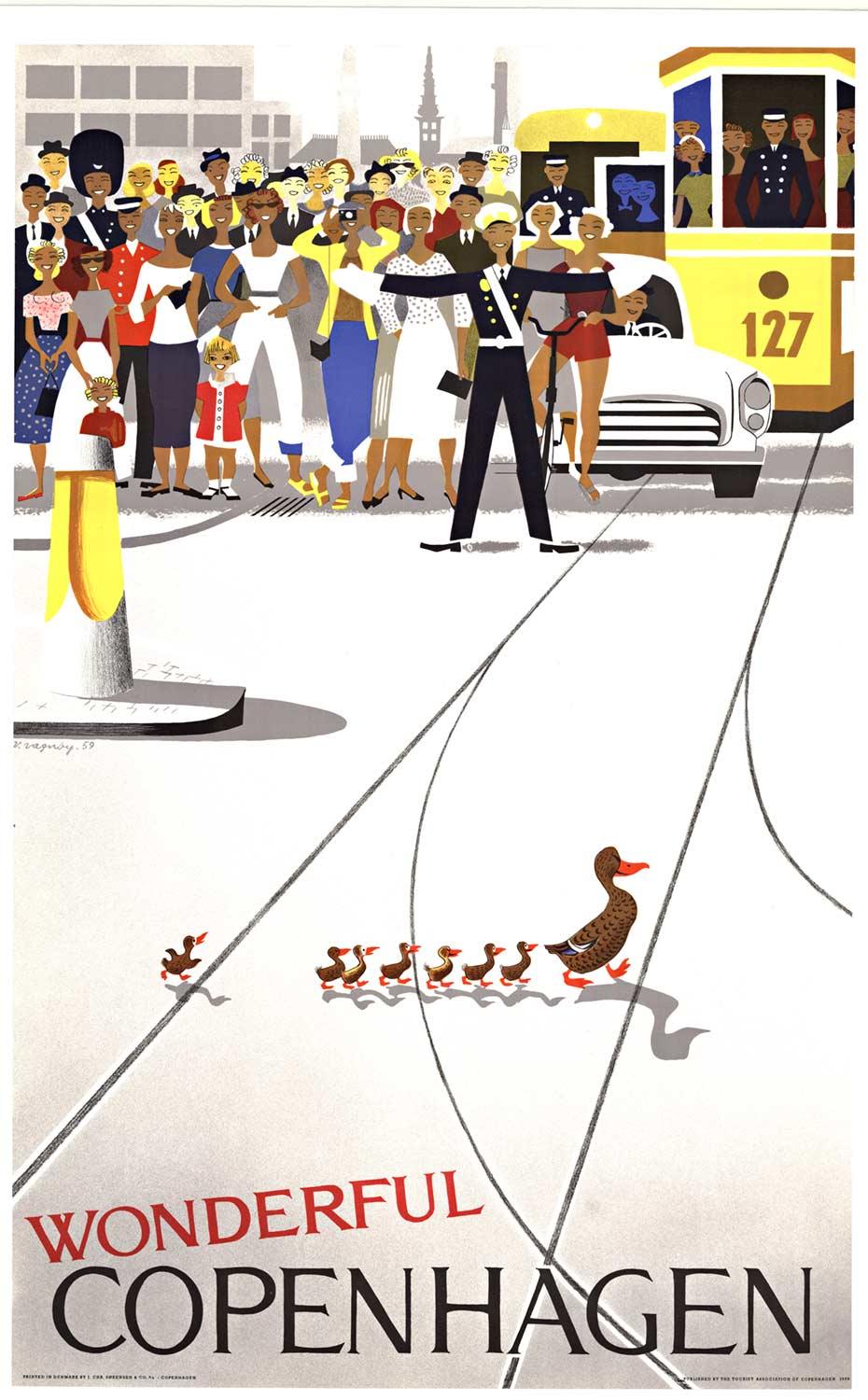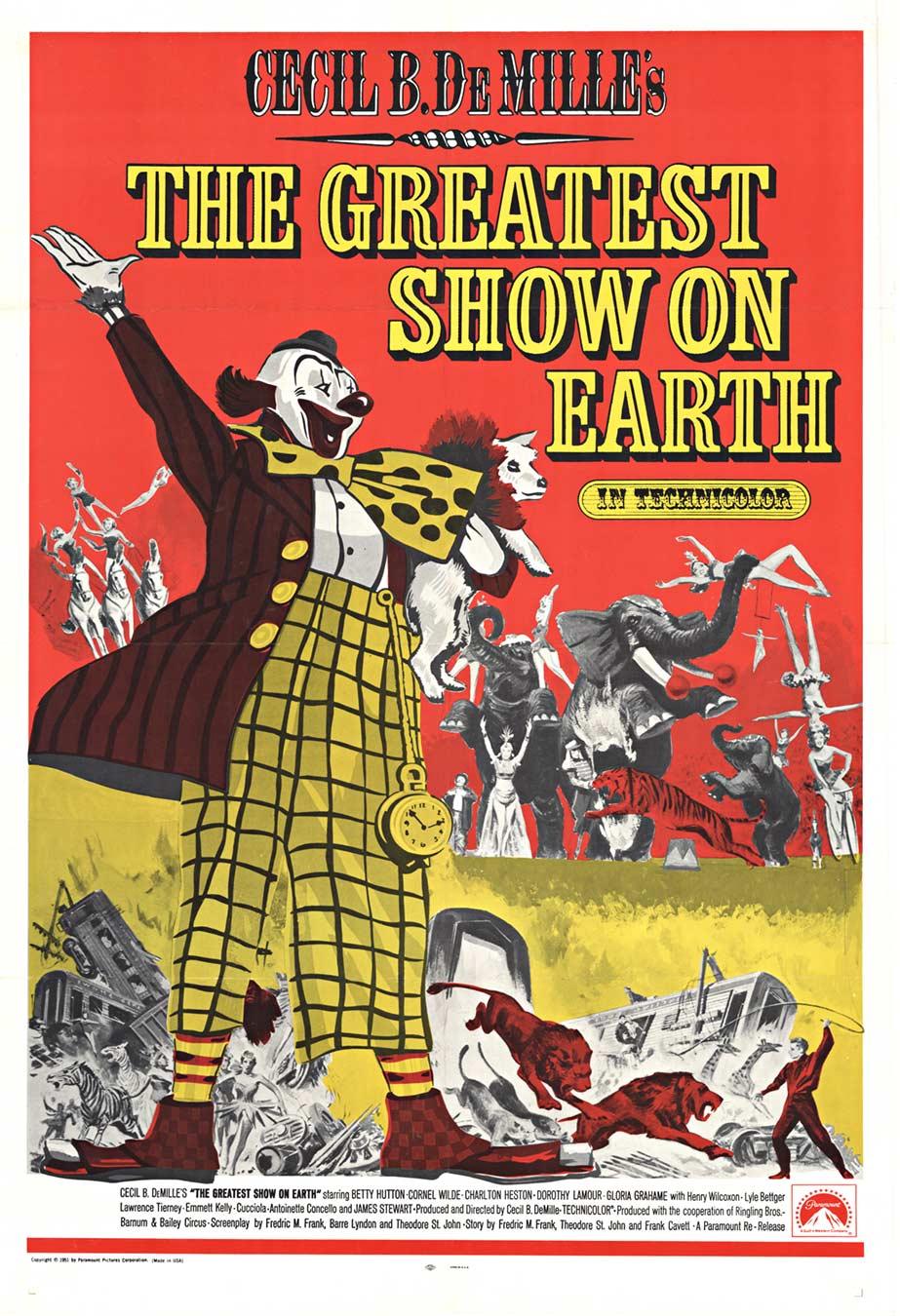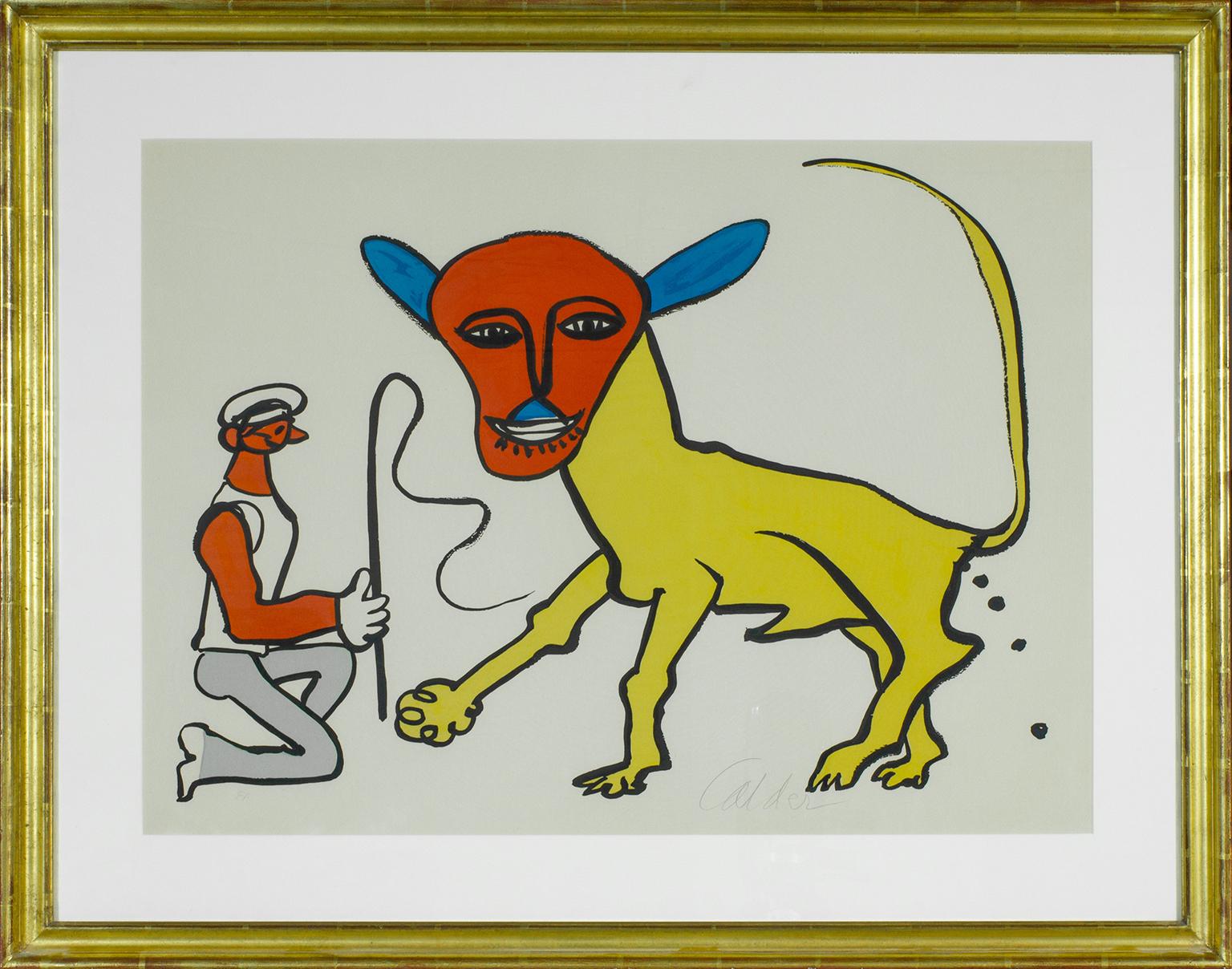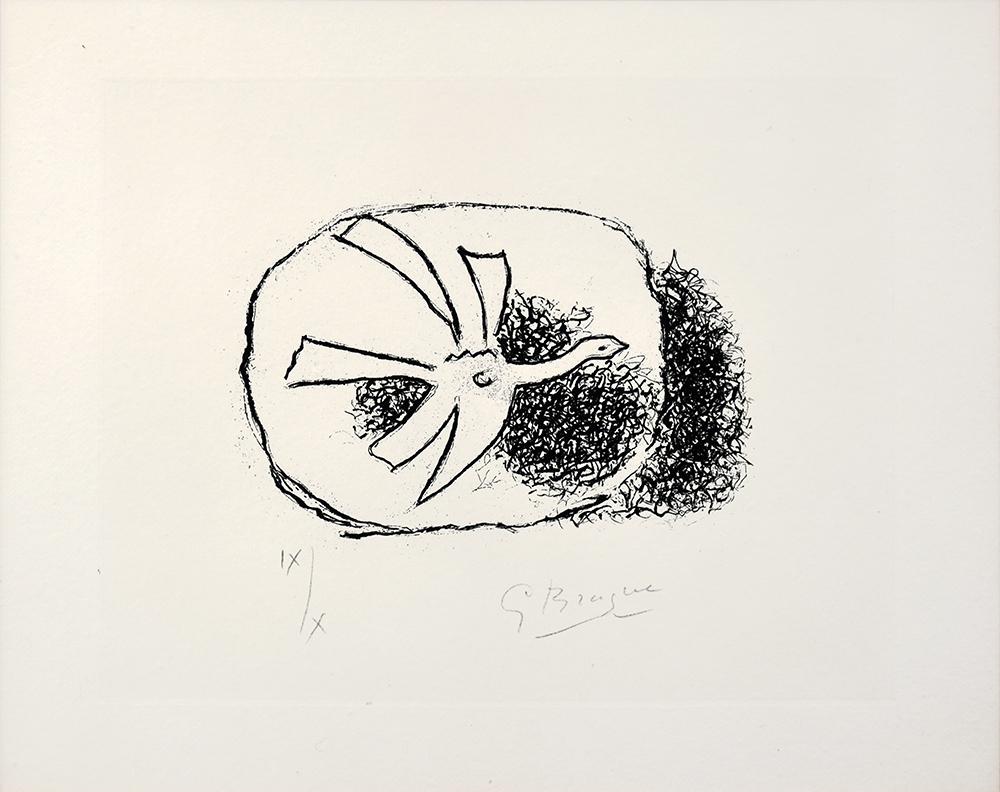Max ErnstMax Ernst - The Soldier - Original Lithograph1972
1972
About the Item
- Creator:Max Ernst (1891-1976, American, German, French)
- Creation Year:1972
- Dimensions:Height: 15.75 in (40 cm)Width: 11.82 in (30 cm)Depth: 0.04 in (1 mm)
- Movement & Style:
- Period:
- Condition:
- Gallery Location:Collonge Bellerive, Geneve, CH
- Reference Number:1stDibs: LU16122354723
Max Ernst
Born in Germany in 1891, later naturalized as an American, then a French citizen, Max Ernst was a pioneer in the Dada and Surrealist movements, the boundaries of which he pushed with his unconventional methods of printmaking, drawing and collage.
Ernst had no formal art training — and that may have been his greatest asset. He produced his first work following four years serving in World War I. At the time, he was in Cologne, Germany, working closely with fellow Dada pioneers Jean Arp and Johannes Baargeld. His output during this period consisted largely of collages, which allowed him to represent the shards, rubble and explosions from his traumatic wartime experience.
In 1922, Ernst moved to France, where he soon became affiliated with Surrealism, the avant-garde art movement taking shape in Paris. Alongside Man Ray, Joan Miró and a couple of others, Ernst was among the first visual artists to experiment with imagery and techniques associated with Surrealism.
Ernst’s greatest contribution to the Surrealist movement was his invention of frottage (French for “rubbing”), wherein an artist rubs a pencil or crayon over a paper atop a textured surface, and later grattage (French for “scraping”), where a similar technique is applied with paint. Both methods showcase Ernst’s fascination with the unconscious and serendipitous elements of artistic creation, a theme that connected the Dadaists and the Surrealists. Ernst had deep knowledge of psychoanalysis and Sigmund Freud’s dream theories, which were big influences on Surrealists. He was among the first Surrealists to use Freud’s work to examine his own creative impulses. He also published a series of books of his collages, all of which were deeply symbolic and often philosophical.
When Germany occupied France during World War II, Ernst escaped to America with the help of patron and collector Peggy Guggenheim, whom he married in 1941. While living in New York, Ernst’s work and techniques proved instrumental in inspiring the early development of Abstract Expressionism — influencing Robert Motherwell and Jackson Pollock in particular. He later moved to Sedona, Arizona, where he lived with his fourth wife, Dorothea Tanning, a fellow Surrealist and prolific visual artist and poet.
While Ernst and Tanning are largely responsible for Sedona’s reputation as an artist colony, they relocated to France in the 1950s and remained until Ernst’s death in Paris in 1976.
Find original Max Ernst art on 1stDibs.
- ShippingRetrieving quote...Ships From: Collonge Bellerive, Geneve, Switzerland
- Return PolicyA return for this item may be initiated within 7 days of delivery.
- Paul Jouve - Eagle - Original EngravingBy Paul JouveLocated in Collonge Bellerive, Geneve, CHPaul Jouve - Eagle - Original Engraving Editions Rombaldi, Paris, 1950. Copy on velin creme de Rives Artwork by Paul Jouve. Original copper engraving heightened with pochoir. Paul...Category
1950s Modern Animal Prints
MaterialsEngraving
- Pablo Picasso - La Petite Corrida - Original LithographBy Pablo PicassoLocated in Collonge Bellerive, Geneve, CHPablo Picasso - Original Lithograph La Petite Corrida (The Small Bullfight) 1958 Edition of 2000, unsigned Published in the journal XXe Siecle Dimens...Category
1950s Modern Figurative Prints
MaterialsLithograph
- Georges Braque - Original LithographBy Georges BraqueLocated in Collonge Bellerive, Geneve, CHGeorges Braque - Original Lithograph 1963 Dimensions: 32 x 24 cm Andre Sauret, Monte Carlo The father of Cubism Three Cubist that distinguishes art historian periods were initiated and developed by Georges Braque: The Cubist Cézanne (1907-1909), Executive (1909-1912) and synthetic (1912-1922). Post-Impressionist and fawn, Braque no longer adheres to the contingency of a decorative way or the other. Cézanne’s paintings exhibited at the Grand Palais during the retrospective of 1907 are a revelation: Cézanne sought and invented a pictorial language. In his footsteps, Braque went to the South with the reasons of the Master. He returned with Estaque landscapes and surprising Ciotat it keeps Cezanne geometric model and retains the “passages” continuity from one surface to another to create the sensation of “turning around” of the object represented. But he wants to go after the consequences of the vision of Cezanne. In his paintings Houses in L’Estaque (1908) it simplifies the volumes of houses, neglects detail by removing doors and windows: the plastic rhythm that builds the table. Large Nude , a masterpiece of the period, can be considered the first work of Cézanne cubism . Systematizing and deepening Braque discoveries open the door analytical cubism. In 1909, his painting became more cerebral than sensual. The pattern is recreated in the two-dimensionality of the canvas, leaving aside any illusionistic perspective. In Still Life with Violin, objects are analyzed facets according to their characteristic elements, each facet referring to a particular view of the object. There are so many facets of points selected view: Table reflects the knowledge of the object and the ubiquity of the eye. Moreover, Braque is looking for the essence of the objects in the world rather than their contingency, which explains the absence of light source and use of muted colors (gray, ocher), contingent aspects of the object . But formal logic has stepped facets, erased any anecdote to the object and ultimately led to his painting a hermetic more marked on the edge of abstraction (see the series of Castle Roche-Guyon ). Braque, anxious to keep the concrete and refusing at all costs that the logic of Cubism takes the paintings to abstract, reintroduced signs of reality in his paintings in 1912 marks the beginning of Synthetic Cubism. Historians speak of “signs of real” rather than reality because what interests Braque, this is not to put reality into a table, but to create a painting which, by its language, refers to the real. To do this, he invented two major techniques XX th century inclusions and contributions. The inclusions consist of painting objects that have no real depth, materials (wallpaper in Nature morte aux playing cards faux wood is a pictorial inclusion) or letters (calligraphic inclusion in Portuguese ), made first brush and a few months later stencil. Contributions are defined in contrast with the collage on canvas of foreign materials: glued or sand paper, sawdust, etc.. Regarding the collages, Braque used for the first time in September 1912 a piece of adhesive paper imitating faux wood Compote and Glass , then the packet envelope of tobacco Bock in 1912-1913, or an advertisement in Damier , 1913). Inputs and inclusions refer to an external object in the table, without “emulate” this object. Away from their appearances, objects are represented in closest essence of the objects in the real world sense. This is also the time of Synthetic Cubism that Braque invented paper sculpture. There are, unfortunately, and no one is living proof of a photograph makes it possible to realize: Paper and paperboard. Métamorphoses period(1961-1963). In 1961, Georges Braque worked on a Greek head for the Louvre, which obsesses him, and he wishes to free his mind. He tried several times to bring out the paint and the result was unsatisfactory. He thinks the ultimate metamorphosis its Greek head projected in three dimensions. He calls in his studio of Baron Heger Loewenfeld, master lapidary, and he communicates his enthusiasm during the “fateful encounter.” Nine months later, in honor of the eighty years of Georges Braque, Heger Loewenfeld offers the Master of the ring Circe: the famous Greek head finally exorcised, carved in an onyx. Braque Loewenfeld then asked to identify other issues that haunt him. From dated and signed by Georges Braque, Heger gouaches Loewenfeld shapes works in the fields of jewelery, lapidary art...Category
1960s Modern Figurative Prints
MaterialsLithograph
- Alfred Manessier - LithographBy Alfred ManessierLocated in Collonge Bellerive, Geneve, CHAlfred Manessier - Lithograph 1962 From the art periodical XXe Siecle (no. 20) Dimensions: 32 x 24 Edition: G. di San Lazzaro. Unsigned and unnumbered as issuedCategory
1960s Modern Figurative Prints
MaterialsLithograph
- Alfred Manessier - Original LithographBy Alfred ManessierLocated in Collonge Bellerive, Geneve, CHAlfred Manessier - Original Lithograph Colorful Abstraction 1962 From XXe Siecle Dimensions: 32 x 24 Edition: G. di San Lazzaro. Unsigned and unumbered as issuedCategory
1960s Modern Figurative Prints
MaterialsLithograph
- Emilio Vedova - Original LithographBy Emilio VedovaLocated in Collonge Bellerive, Geneve, CHEmilio Vedova - Original Lithograph Abstraction 1961 From the art revue XXe Siecle Dimensions: 32 x 24 Edition: G. di San Lazzaro. Unsigned and unumbered as issuedCategory
1960s Modern Figurative Prints
MaterialsLithograph
- Original "Wonderful Copenhagen" vintage travel posterLocated in Spokane, WAOriginal vintage poster: WONDERFUL COPENHAGEN created by the artist Viggo Vagnby. This antique poster is archival linen backed, in excellent co...Category
1950s American Modern Animal Prints
MaterialsLithograph
- Original "The Big Show" vintage US 1-sheet movie poster 1961Located in Spokane, WAOriginal "The Big Show", US 1-sheet linen-backed movie poster from 1961. Very fine condition. Professional restoration of original theater fold marks. A - A- condition, ready t...Category
1960s American Modern Animal Prints
MaterialsOffset
- Original "The Greatest Show on Earth" 1951 vintage movie poster US 1-sheetLocated in Spokane, WAOriginal “The Greatest Show on Earth” vintage US 1 sheet movie poster. Cecil B DeMille’s 1951 movie. Archival linen backed in very good condition, ready to frame. Original theater-issued fold marks restored during linen backing. Over 70 years old, 1st printing. Welcome to the circus. The Greatest Show on Earth starring Betty Hutton, Cornel Wilde, Charlton Heston, James Stewart (Jimmy Stewart...Category
1950s American Modern Animal Prints
MaterialsOffset
- Oiseau dans son nid (Bird in its Nest) from Août (August)By Georges BraqueLocated in Palo Alto, CABraque Oiseau dans son nid (Bird in its Nest) from Août (August), 1958 is an exquisite work that revisits Braque’s beloved bird motif. Beautifully inspir...Category
1950s Modern Figurative Prints
MaterialsAquatint
- Barnacle Geese AffrightedLocated in Middletown, NYEtching and drypoint on cream wove paper, full margins. Signed and numbered 59/75 in pencil, lower margin. Notations in pencil along the lower sheet edge, recto, well outside of ima...Category
Mid-20th Century Modern Animal Prints
MaterialsHandmade Paper, Drypoint, Etching
- Melonen-kaufer (Melon Seller).By Maria ResselLocated in Storrs, CTEtching printed in grey/green. 5 1/4 x 7 (sheet 9 3/4 x 12 5/8). A fine impression with plate tone printed on cream wove paper. Signed and titled in pencil. Housed in a 16 x 20-inch...Category
Early 20th Century Modern Figurative Prints
MaterialsColor, Etching






